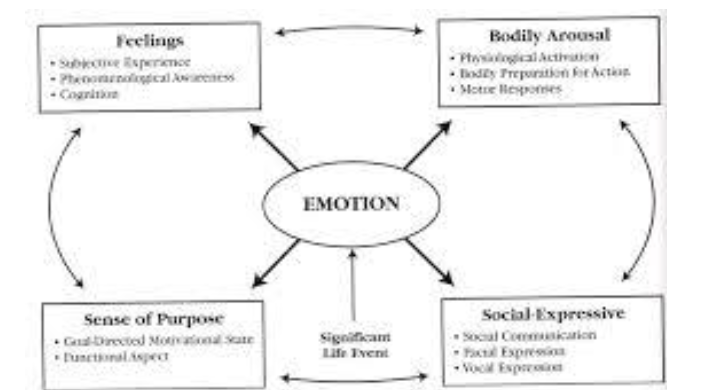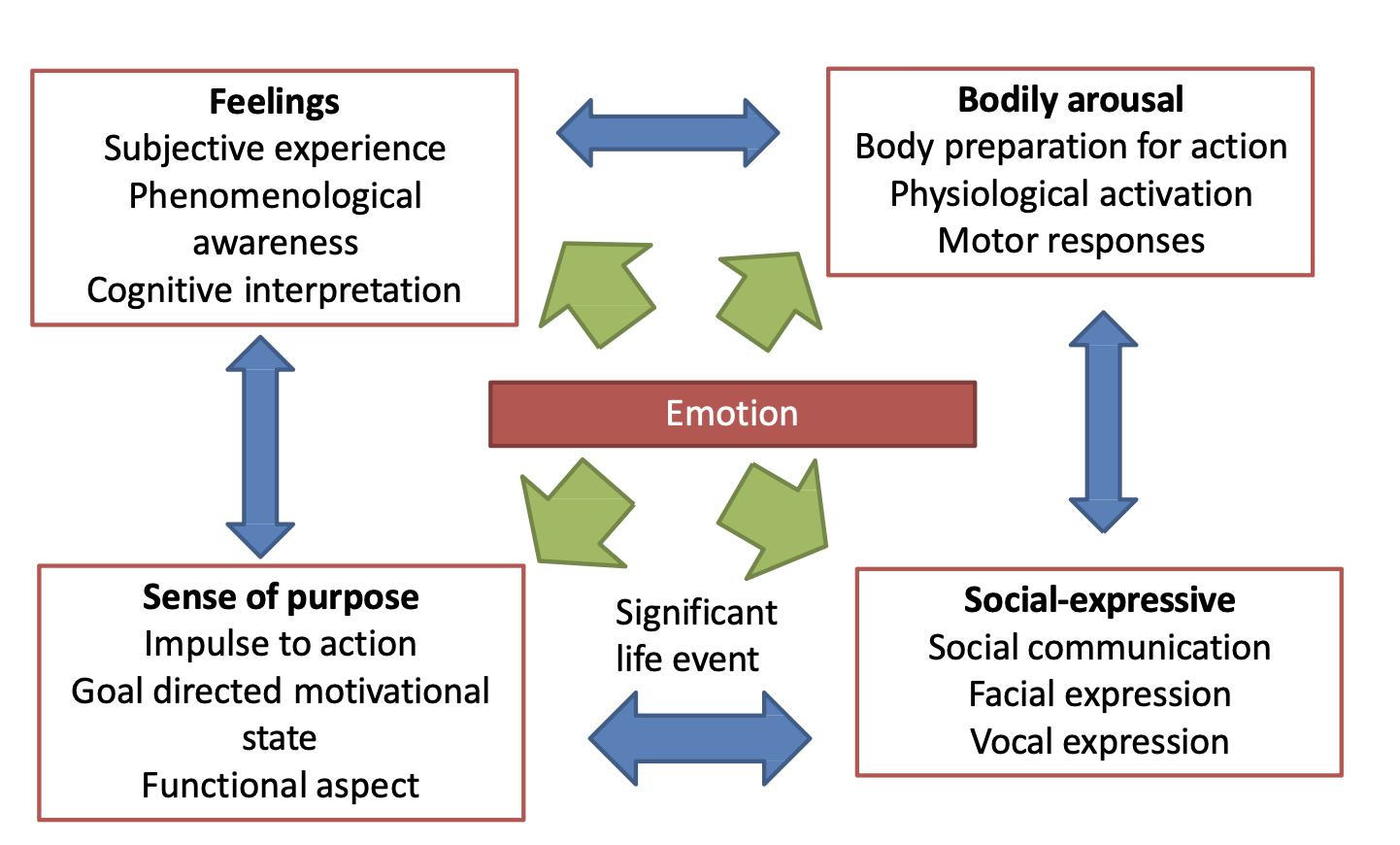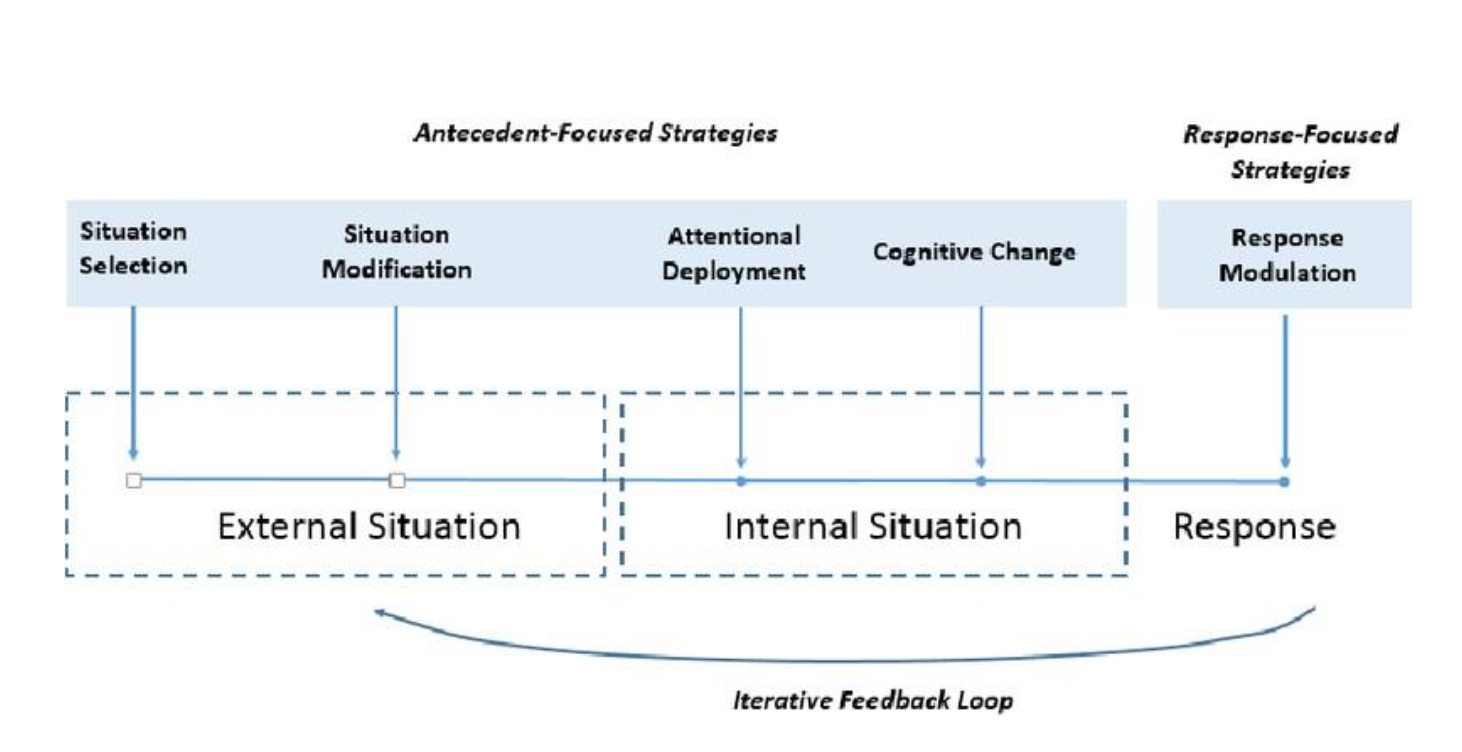5.0 emotions Motivation and Emotion
1/76
Earn XP
Description and Tags
Motivation and Emotion
Name | Mastery | Learn | Test | Matching | Spaced |
|---|
No study sessions yet.
77 Terms
The components of emotion
Feeling component
Physiological component
Motivational component.
Expressive component.
Emotions related to other affective processes
Emotions & moods
Emotions & feelings
What is an Emotion
Exist of four emotional components
Related to other affective processes.
The emotional episode.
Emotional regulation Strategies
Functions of emotions
Emotion is “in vogue” (authors)
Kahneman
Damasio
Haidt
Damasio
Neuropsychology
Kahneman
Behavioral Economics
Haidt
Social Psychology
emotions Today
Analyzing emotions is solid business
Problem arises when we try to define the concept.
William James → emotions
Multidimensional concepts
Exist as subjective, social, biological & intentional phenomena.
adapt to four perspectives
not a unique definition for emotion
What is an emotion?
complex
subjective, biological, purposive & social phenomena
Emotions are short-lived, feeling–arousal–purposive–expressive phenomena
To understand emotions
Need to analyze each of these dimensions
How they interact with one another.
We think of an emotion as
moves us–a feeling we experience.
emotions from latin → “MOVING”
Emotions are short-lived, feeling–arousal–purposive–expressive phenomena
Help us adapt to the opportunities & challenges we face during important life events.
Emotions definition depends on
feelings
sense of purpose
social expressive
bodily arousal
significant life event

FEELINGS
Subjective experience
Gives emotion its subjective quality.
Provides meaning & personal significance.
Intensity & quality, emotion is felt and experienced at the subjective
Rooted in cognitive or mental processes
PHYSIOLOGICAL ACTIVATION
Includes our neural & physiological activation
The activity of the autonomic & hormonal-systems.
Brain activation, bodily arousal, & physiological activity =
→ intertwined with emotion that any attempt to imagine an angry or disgusted person who is not bodily aroused is nearly impossible.
PURPOSIVE COMPONENT
Gives emotion its goal-directed character to take the action necessary to cope with the circumstances at hand.
It is the impulse to act in a certain way.
LONG-TERM based
example of PURPOSIVE component
The person without emotions would be at a substantial social & evolutionary disadvantage to the rest of us.
Emotions ingredients
Feeling
Physiological
Purposive behaviour
social-expressiveness
SOCIAL EXPRESSIVE COMPONENT
Emotion’s communicative aspect.
NON-VERBAL COMMUNICATION
e.g. Postures, Gestures, Vocalizations, Facial expressions.
illustration

Feelings
Subjective experience
Phenomenological awareness
Cognitive interpretation
Sense of purpose
Impulse to action
Goal directed motivational state
Functional aspect
Bodily arousal
Body preparation for action
Physiological activation
Motor responses
Social-expressive
Social communication
Facial expression
Vocal expression
Relationship between motivation & emotion
Latin root of both words → movere (to move), supports this relationship
emotion & motivated linked to pressure and heat.
Both constructs rely on the relationship between an individual and their environment
Both rely on overlapping brain structures (amygdala, hypothalamus, nucleus accumbens)
Emotions relate to motivation in two ways
a type of motiv → energies & direct behaviour
ongoing readout system → indicate how well or poorly personal adaption is going → reflect satisfied versus frustrated status of other motives.
According to Tomkins emotions & motivation
if we take away the emotion = we take away motivation.
illustration → of motivation = emotion

Emotion in relation to
other affective processes
mood
feelings
EMOTION
Caused by specific events
Very brief duration
Specific & numerous in nature (there are several emotions: anger, fear, sadness, happiness, disgust, surprise).
Usually accompanied by distinct facial expressions
Action-oriented in nature
MOOD
The cause is often general & unclear
Last longer than emotions
More general (two main dimensions: positive or negative)
Generally not indicated by distinct expressions
Cognitive in nature; they influence what we think.
Emotions & feelings
mental events to reaction of emotions
originate in the neocortical regions of the brain
Influenced by experience, belief, & memories.
Portrayal of what is happening in your body.
byproduct of your brain perceiving & assigning meaning to the emotion.

Damasio says that feelings
are mental experiences of body states → arise when the brain interprets our emotions.
While emotions are inborn & common to everyone
The meanings they acquire & the feelings they prompt are personal.
The emotional episode (model by GROSS)
Situation
Attention
Appraisal
Response
Situation
The sequence begins with a stimulus—whether real or imaginary, past or present—that the individual finds emotionally relevant.
Attention
Our focus of attention is directed towards the situation.
Appraisal
The situation is analyzed
Response
The emotional response is generated, provoking coordinated experiential, behavioral, & physiological changes.
Emotion Regulation Process:
process → an individual can modify the onset, duration, magnitude, latency, intensity, or nature of one or more aspects involved in the emotional response
Emotion Regulation can
Dampen or intensify emotions, depending on the individual's goals
regulatory processes
Automatic or controlled
Conscious or unconscious
Can affect one or more stages in the emotional generative process.
prototypical episode of emotion regulation
is controlled → influence individuals’ spontaneous emotional responses
Emotion regulation inn affective litterature
one of the most popular research areas
since 2009 → More than two-thirds papers on emotion regulation (published) → most focused on intrinsic processes
unresolved issue in emotional regulation →
whether it refers to:
intrinsic processes (FREDU)
extrinsic processes (SALLY/Bob’s emotions)
or both
EMOTION REGULATION STRATEGIES
Antecedent-focused strategies
Response-focused strategies
Antecedent-focused strategies: involves
Situation selection
Situation modification
Attentional deployment
Cognitive change
Response-focused strategies: involves
Response modulation
Situation selection
happens before the situation
it is like we know what to expectations → & we behave accordingly e.g, avoiding a situation that lead to an emotions
Situation modification
inside the Situation
able to change the situation / changing the scenario objectively
Attentional deployment
Attention
attention deployment → “ignore it”
distraction → think of something else
Cognitive change
Appraisal
Response modulation
Response
Situation selection
taking actions that make it more (or less) likely for one to find oneself in a situation expected to elicit desirable (or undesirable) emotions.
Examples of situation selection include
Approach strategies (e.g., spending time with supportive friends when you are upset)
or avoidance strategies (e.g., declining invitations to events that make you feel anxious).
Barrier of situation selection
backward- and forward-looking biases
short-term benefits of emotion regulation against the longer-term
costs.
backward- and forward-looking biases
makes it difficult to accurately represent past or future situations for the purposes of situation selection.
Situation modification
Efforts to change the scenario & reduce its emotional impact.
This strategy addresses the source of emotional responses directly.
- efforts to modify may effectively create a new situation altogether.
Attentional deployment
Refers to how individuals direct their attention within a given situation to influence their emotions.
DISTRACTION
CONCENTRATION
MINDFULNESS
DISTRACTION
Focuses attention on different aspects of the situation, or moves attention away from the situation altogether.
Changing of internal focus: individuals invoke thoughts or memories that are inconsistent with the undesirable emotional state
MINDFULNESS
psychological process
bringing one's attention to the internal & external experiences occurring in the present moment
developed through the practice of meditation & other training
CONCENTRATION
draws attention to emotional features of a situation.
rumination
rumination
attention is directed in a repetitive way to one’s feelings & consequences
Cognitive change
Changing how one appraises the situation → to alter its emotional significance
either by changing how one thinks about the situation or about one’s capacity to manage the demands it poses.
REAPPRAISAL
Type of cognitive change
Altering the meaning of a situation in a way that changes its emotional impact
More effective when emotions are generated in low-intensity negative situations or when emotions are elicited in a top-down fashion.
Response modulation
occurs late in the generative process, after response tendencies
influencing physiological, experiential, or behavioral responses as directly as possible
response modulation can include
suppressing emotional expressions
altering physiological response (for instance, controlling heart rate)
modifying behaviors in response to stimuli.
Emotional suppression involves
regulating emotion-expressive behavior
provokes → expressive dissonance
misalignment between internal experience & its overt expression
Response modulation, particularly emotional suppression →
Significant attention in the affective literature
Less beneficial
Not effectively reduce negative emotional experiences.
FUNCTIONS OF EMOTIONS
main role of emotion is contributing to our personal adaptation
INTRAPERSONAL FUNCTIONS
INTERPERSONAL FUNCTIONS
INTERPERSONAL FUNCTIONS
Help us understand how we feel & exert influence on others' emotional states.
They shape our position in relation to others & establish boundaries between ourselves & them.
INTRAPERSONAL FUNCTIONS
Emotions coordinate subjective, physiological, & behavioral systems.
Change our behavioral hierarchies & activate unexpected behaviors.
They provide physiological support for our behaviors.
They enable fast information processing.
They highlight important information.
Antecedent - focused strategies
Situation selection → Situation modification → attentional deployment → cognitive change → response modulation
External situation
Situation selection → Situation modification
Internal situation
attentional deployment → cognitive change
response
Response modulation
→ leading again to interactive feedback loop → external situation
Illustration of Antecedent - focused strategies
